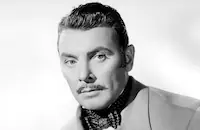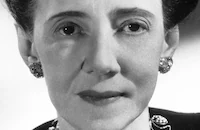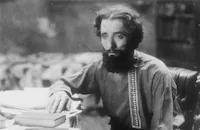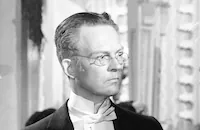Miss Pinkerton

Brief Synopsis
Cast & Crew
Lloyd Bacon
Joan Blondell
George Brent
Ruth Hall
John Wray
Elizabeth Patterson
Film Details
Technical Specs

Synopsis
Nurse Adams is sent to the Mitchell house to care for Julia Mitchell, who is in shock after discovering the body of her nephew, Herbert Wynne. Her supervisor tells her that she will be working undercover for the police, who suspect that Wynne was murdered. Police inspector Patten, the man in charge of the case, secretly tells Adams that Wynne was killed by someone he knew. Later, when he learns that Wynne recently took out a life insurance policy, Patten changes his mind and decides that Wynne committed suicide. Patten suspects that Wynne shot himself through a newspaper so as not to leave powder burns, and asks Adams to look for the newspaper. While she is searching the house, Adams meets Paula Brent, who says that she was Wynne's fiancée. Paula believes that someone in the family killed Wynne for the insurance money, but at the inquest, Wynne's death is declared accidental. Meanwhile, Adams sees a mysterious stranger creeping around, who grabs her and locks her in a closet. Adams's screams lead the family to summon the police, who find Charles Elliott holding a newspaper with a bullet hole in it. They arrest Charles even though Adams is sure he did not kill Wynne. Julia is very distressed when she hears about the arrest and summons her lawyer Arthur Glenn. Outside the room, Paula begs Adams to let her search Wynne's room to clear Charles. While they are talking, Glenn asks Adams and his stenographer Florence Lenz to witness Julia's signature on a statement which they do not read. Then Dr. Stewart gives Julia a shot for her heart. Moments later, Julia dies because someone substituted arsenic for the amyl nitrate, but before she learns of the death, Adams washes the hypodermic which causes the doctor to report her to the police. Paula then is found with a marriage license revealing her secret marriage to Wynne. This revelation seems to give Charles a motive, so Patten questions him again and Charles admits that he and Paula are in love. According to Charles, on the night of the murder, he was trying to discourage Wynne from bothering Paula, when he heard someone coming up the stairs and climbed out the window. While Charles is telling his story, the police find Hugo, the butler, has been drugged. Hugo demands that they question Florence. When they do, the police learn that Glenn arranged a plan to cheat the insurance company. Wynne was supposed to marry Paula, fake a suicide and disappear so he and Paula could collect the money. Instead Wynne refused to disappear, and so Glenn murdered him. Glenn later killed Julia to prevent her from revealing that she hid the paper through which the shots had been fired in order to collect Wynne's life insurance. Julia thought that Adams and Florence were witnessing her signature on a confession, but Glenn substituted a blank piece of paper and destroyed the confession. Now that the case is solved, Patten invites Adams to accompany him on a new case, but she just wants to return to the peace of the hospital.

Director

Lloyd Bacon
Cast

Joan Blondell

George Brent

Ruth Hall

John Wray

Elizabeth Patterson

C. Henry Gordon

Holmes Herbert
Mary Doran
Blanche Frederici

Mae Madison
Allan Lane

Nigel De Brulier
Eulalie Jensen

Donald Dilloway
Treva Lawler

Luana Walters

Lucien Littlefield
Crew
Niven Busch
Ray Curtiss
Leo F. Forbstein
C. Dave Forrest
Kenneth Green
Lillie Hayward
Barney Mcgill
Jack Okey
Robert Tasker
Homer Van Pelt
William Whitley

Film Details
Technical Specs

Articles
Miss Pinkerton
By Violet LeVoit

Miss Pinkerton
Quotes
Trivia
Notes
The novel was first published as a serial in The Saturday Evening Post (2 January-13 February 1932). Film Daily notes that Donald Dilloway replaced Norman Foster in the cast. The novel was also the basis for the 1941 Warner Bros. film The Nurse's Secret, which was directed by Noel Smith and starred Lee Patrick and Regis Toomey.















